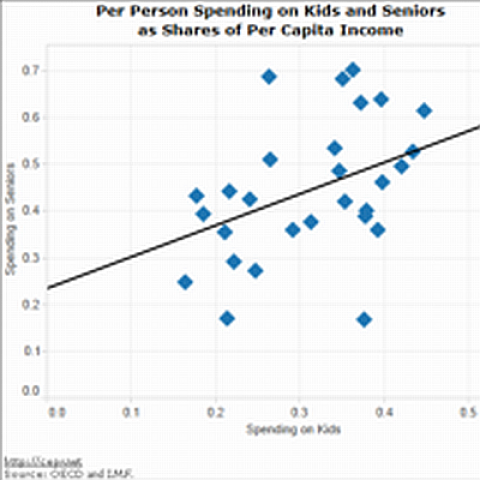A common refrain in debates over Social Security and Medicare is that these programs are putting seniors ahead of children. The implication is that there is a fixed pool of tax revenue. If more of this revenue goes to seniors to pay for their benefits, there is less to cover the cost of child nutrition and health care, daycare, education and other programs that benefit the young. To put in crudely, in this view, a dollar spent on the elderly is a dollar taken away from spending on children.
There is an alternative perspective. The amount of money that the government collects in tax revenue may not be fixed. Understood this way, people's willingness to pay taxes may depend on their perception of the usefulness of the services provided. This could mean, for example, that if the public believes that the government services being provided to both seniors and children are valuable and should be expanded, they would be willing to pay higher taxes to support those services.
If we look at the situation historically in the United States, we have vastly increased the share of GDP going to government programs for both seniors and the young over the last 60 years. In 1950, Social Security payments were less than 1 percent of GDP and Medicare and Medicaid did not even exist. By comparison, we are now spending almost 5 percent of GDP on Social Security, and more than 5 percent of GDP on Medicare and Medicaid.
This growth in federal spending for programs that primarily benefit seniors has been accompanied by a huge expansion in programs intended to primarily benefit the young, such as Head Start, the Women, Infant and Children Nutrition Program, and the State Children's Health Insurance Program. In addition, state and local funding for education and other programs that benefit the young has also hugely increased relative to the size of the economy over the last six decades. People have been willing to pay more in taxes to finance programs that benefit both the elderly and the young.
There is a similar story if we look across countries. If the tradeoff view were correct, we should find that countries that are more generous in their support of seniors are stingier when it comes to public support for their children and vice versa. However, the opposite appears to be the case. If we control for the relative income of different countries, it turns out that a dollar of additional spending per kid is associated with 67 cents of additional spending for each senior. (This relationship is statistically significant at the 5 percent confidence level.)
In short, the data suggest that more spending on seniors is associated with more spending on kids. Presumably this indicates that countries where people rely on the government to ensure that their seniors have a decent standard of living are also inclined to provide the government with resources necessary to ensure that their children's needs are also met.
This evidence suggests that cuts to programs for seniors may be unlikely to end up benefitting our kids. Rather such cuts may be associated with reduced spending on kids as well. If the public does not trust the government to provide good care for seniors, it may also not trust the government to provide good care for children.
In that case, there would be no tradeoff between spending on seniors and spending on kids. If we care about both our seniors and our kids, and trust the government programs designed to provide support at both ends of life, then both sets of programs are likely to be adequately funded. In the opposite case, neither set of programs is likely to be adequately funded. The world where just one set of programs, either those supporting seniors or those supporting kids, receives adequate funding seems largely the invention of politicians.


Spread the word